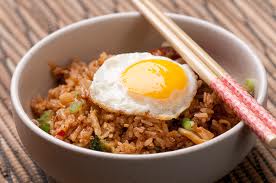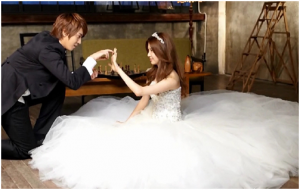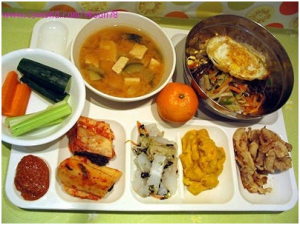Series 1 of Korean Food : Japchae (잡채) Recipe
Japchae is one of the best Korean traditional foods have been still loved for every Korean regardless of gender and age. The dish is often served in Korean traditional Holidays such as Lunar New Year, Chuseok (추석/ kind of Korean Thanksgiving Day) and even someone’s birthday.
Japchae is a healthy and delicious food made with chewy cellophane noodle from sweet potato starch. 잡채 (Japchae) literally means a mix of chopped vegetables but modernized Japchae is a cooked noodle mixed up with many kinds of cokked vegetables and meat. Japchae is also very good dish for vegetarian if you make it without meat. You may choose the kind of vegetables you prefer. Japchae is a very colorful, tasty and highly nutritious food.
Let’s have a look at ingredients and how to cook it now!
Ingredients
200g japchae sweet noodles
1 onion, finely sliced
1 carrot, finely julienned
1 green or yellow capsicum, julienned
6~10 shitake mushrooms, soaked until soft and sliced into 5mm
Cooked spinach
100g lean beef, cut into thin strips (around 5~7mm)
Soy sauce
2 tbsp brown sugar
2 tbsp sesame oil
Sesame seeds
Vegetable oil
Pepper and salt
How to cook
1.Preparing beef
Marinate the sliced thin beef with 1/2 tbsp soy sauce, pepper and sesame oil.
(If you want to remove the bad smell of meat, add a pinch of ginger power.)
Place it for 15 minutes.
Stir-fry them with vegetable oil in a pan over high heat until cooked through.
Put it on the platter.
2. Preparing shitake mushroom
Marinate the sliced mushroom with 1/2 tbsp soy sauce, pepper and sesame oil.
Place it for 15 minutes.
Stir-fry them with vegetable oil in a pan over medium heat.
Put it on the platter.
3. Preparing spinach
Put your spinach in a pot of boiling water and blanch it slightly for around 30 seconds.
Do not overcook.
Then rinse it in cold water 2~3 times and squeeze it lightly.
Chop it in half or into 5~7cm long.
Mix it with a pinch of salt, sesame oil, sesame seeds and pepper.
Put it on the platter.
4. Preparing carrots and onions
Cut carrots into strips and stir-fry it until they soften.
Add a pinch of salt. Just season to taste.
Put it on the platter.
Cook sliced onions with the same way.
5. Preparing capsicums.
Julienne capsicums into 5mm. It doesn’t need to be precooked.
6.Preparing noodles
Cook the noodle in plenty of boiling water for around 5 minutes.
When it is cooked thoroughly, it will look translucent.
If you are not sure of it, just taste it J. But do not overcook.
Rinse in cold water and drain well.
Cut the noodles into around 15cm.
7. Making Sauce
Mix 3 tbsp soy sauce, 2 tbsp brown sugar, 2 tbsp sesame oil and sesame seeds.
Add a pinch of pepper.
8. Mix every ingredient.
Put the noodles into a big bowl.
Add stir-fried beef, marinated shitake mushroom and precooked all vegetables.
Mix all ingredients smoothly with premade sauce.
Depending on your taste, control the amount of soy sauce or sugar.
Kim Yuna (김연아), the princess of figure skating
Not many Australians would doubt that Ian Thorpe is the nation’s sports hero. Every kid want to swim like him and feel proud of his name since he made the country’s image as the strongest country in water sports.
Like Ian Thorpe, in Korea, we do have Kim Yuna (김연아) who is a South Korean figure skater. You can easily see her face on tv commercials and catalogues of major corporations in South Korea.
She’s a one of a kind figure skater and her career supports it strongly. She is the 2010 Olympic champion in ladies’ singles, the 2009 World champion, the 2009 Four Continents champion, a three-time (2006–2007, 2007–2008, 2009–2010) Grand Prix Final champion, the 2006 World Junior champion, the 2005 Junior Grand Prix Final champion, and a four-time (2002–2005) South Korean national champion. She is the first South Korean figure skater to win a medal at an ISU Junior or Senior Grand Prix event, ISU Championship, and the Olympic Games. She is the first female skater to win the Olympic Games, the World Championships, the Four Continents Championships and the Grand Prix Final. She is one of the most highly recognized athletes and media figures in South Korea.
In May 2011, Kim began to host a show called “Kim Yu-na’s Kiss and Cry”. The program portrayed the challenging process of ten popular entertainers as they learned how to figure skate from professional skaters. The ten stars included comedian Kim Byung-man, singer U-Know of TVXQ, Krystal of f(x), IU, Son Dam-bi, actors Park Jun-geum, Seo Ji-suk, Lee Ah-hyun, Jin Ji-hee and speed skater Lee Kyu-hyuk.
Kim has stated that she hopes to become a member of the International Olympic Committee (IOC) after the 2014 Sochi Games.
Her challenge and inspiration would never stop!
Ashley (Korean teacher)
Christmas in Korean
Christmas is just around the corner! Unlike sunny sizzling Sydney Christmas, we have a cold (approx -5’C) and snowy Christmas in Korea. White Christmas indeed!
Let’s learn one Christmas Carol in Korean! Here is a song performed by the K-pop super group, DBSK , when the 5members were together. It is still considered as the best ‘a cappella Carol’ in Korea.
고요한 밤 거룩한 밤 (Silent Night, Holy Night Korean Version) by 동방신기(DBSK)
HANGEUL
[믹키] 고요한 밤 거룩한 밤 어둠에 묻힌밤
[최강] 주의 부모 앉아서 감사 기도 드릴때
[영웅] 아기 잘도 잔다 아기 잘도 잔다
[시아] 고요한 밤 거룩한 밤 영광이 둘린 밤
[유노] 천군 천사 나타나 기뻐 노래 불렀네
[영웅] 왕이 나셨도다 왕이 나셨도다
[시아] 왕이 나셨도다 왕이 나셨도다
[All] 왕이 나셨도다
ROMANISATION
Goyohan Bam Gorughan Bam
[Micky]
Goyohan bam gorughan bam
Odume mudhinbam
[Changmin]
Juye bumo anjaso gamsa gido durilte
[Jaejoong]
Agi jaldo janda agi jaldo janda
[Xiah]
Goyonhan bam gorughan bam
Yonggwangi dullin bam
[Yunho]
Chongun chonsa natana
Gippo nore bullone
[Jaejoong]
Wangi nashododa
Wangi nashyododa
[Xiah]
Wangi nashyododa
Wangi nashyododa
[All]
Wangi nashyododa
– Ashley Jang (Korean language teacher)
Korean New Year
Korean new Year is typically a family holiday. The three-day holiday is used by many to return to their hometowns to visit their parents and other relatives, where they perform an ancestral ritual. Many Koreans dress up in colorful traditional Korean clothing called hanbok. But nowadays, small families tend to become less formal and wear other formal clothing instead of hanbok. Many Koreans greet the New Year by visiting East-coast locations such as Gangneung and Donghae in Gangwon province, where they are most likely to see the first rays of the New Year’s sun.[2]
Tteokguk
Tteokguk (떡국) (soup with sliced rice cakes) is a traditional Korean food that is customarily eaten for the New Year. According to Korean age reckoning, the Korean New Year is similar to a birthday for Koreans, and eating Tteokguk is part of the birthday celebration. Once you finish eating your Tteokguk, you are one year older.
Sebae
Sebae is a traditionally observed activity on Seollal, and is filial-piety-oriented. Children wish their elders (grandparents, aunts and uncles, parents) a happy new year by performing one deep traditional bow (rites with more than one bow involved are usually for the deceased) and the words saehae bok mani badeuseyo (Hangul: 새해 복 많이 받으세요) which translates to Receive many New Year blessings, or more loosely, “Have a blessed New Year.” Parents typically reward this gesture by giving their children new year’s money, or “pocket money,”
The king of Korean Home Food “ Kimchi Fried Rice (Bokeumbap)” Recipes
Kimchi Fried Rice (Bokeumbap) is humble food that is mostly enjoyed at home, but you might also see it in some casual Korean eateries. At home, it’s a great way to use leftover kimchi that’s a bit past its prime. Quick, easy, and cheap to make, kimchi bokeumbap is simple Korean home cooking at its best.
Prep Time: 5 minutes
Cook Time: 15 minutes
Total Time: 20 minutes
Ingredients:
- 1 cup kimchi, drained and chopped (preferably a bit old and sour Kimchi)
- 1/2 sweet onion, chopped
- 1 Tbsp soy sauce
- 1 Tbsp butter
- 1/3 cup thinly sliced beef/ spam/ pork/ bacon/ tuna or ham
- 3 cups cooked rice
- Salt to taste
- 1 Fried egg for each serving
Preparation:
- If using bacon, saute briefly on an ungreased large pan and omit oil from next step. With any other meat or a vegetarian version, start with step #2.
- Saute kimchi and onion in a lightly greased large pan over medium heat for a few minutes.
- When vegetables begin to look transparent, add ½ Tbsp of butter, garlic, and soy sauce and saute for another 2-3 minutes.
- Add meat or pork and continue to saute until meat is cooked.
- Turn heat off but keep pan on burner.
- Add rice and rest of butter, mixing to combine.
- Salt to taste and top with fried egg to serve.
(Serves 4)
Learning Korean from Korean T.V show
We got married! 우리 결혼했어요 (우결)
We Got Married (우리 결혼했어요) is one of the popular variety shows on MBC. The show is directed for the purpose of how couples of Korean celebrities could show what life would be like if they were married. Each week, couples are assigned missions to complete, with candid interviews of the participants to reveal their thoughts and feelings. The variety show tells you how young couples would solve the troubles of their love and marriage throughout the interesting episodes.
The show, 우리 결혼했어요, let us think of some interesting questions which everyone would have ever thought about once such as “If I were ~ or If we are” While you watch the show, you may be confused what is real or imaginary. Now, the season 4 is still going on since the first season started in 2008. In the season 4, you can enjoy exciting episodes between new couples, Jullien Kang & 윤세아, 황광희 & 한선화 (one of members of Secret), 이준 & 오연서. Nowadays, 황광희, one of the member of ZE:A, is a budding rookie in many reality variety shows.
Shall we learn Korean past tense from the show title?
The sentence, 우리 결혼했어요, means “We got married”. It is a past tense. How to say something of what you did in Korean?
Before you move on to the next step, you need to know the structure of the Korean verbs first. All Korean verbs end in –다 such as 보-다(to see, watch), 먹-다(to eat), and 공부하-다(to study). Korean verbs are divided into two parts, stem part and ending part. The ending part is always –다. In the word, 공부하다, 공부하 is a stem part and –다 is an ending part.
Korean past tense can be made with –았어요/-었어요/-했어요. Depending on the vowel in the last syllable in each verb stem, -았어요, -었어요 or –했어요 should be attached to the stem part. At this time, -다 ending part is deleted.
If the last syllable in any verb stem has a ‘ㅏ’ or ‘ㅗ’ vowel, -았어요 is added. For example, you can separate the verb 보다 (see, watch) into 보 and 다. 보-(stem part) has a ‘ㅗ’ vowel, so –았어요 is added. Then without –다, 보 is combined with –았어요. So it becomes 보-았어요. It means ‘saw’.
To another verbs has other vowels excepting ‘ㅏ’and ‘ㅗ’ in the last syllable in the stem, -었어요 is combined. For example, 먹-다 which means eat, has a ‘ㅓ’vowel in its stem. So the stem part can put together with –었어요. Finally, 먹 and –었어요 become 먹었어요 which means ate.
All verbs ending in하다 become –했어요. For example, 공부하다(study) becomes 공부했어요 (studied). As you seen the title of ‘우리 결혼했어요’, 결혼했어요 comes from the basic form ‘결혼하다 (get married)’. You can use the expression ‘-했어요’ in many ways. It means “I did something”.
저는 한국어 공부했어요. (I studied Korean/ Jeoneun hangugeo gongbuhaetsseoyo)
저는 비빔밥 먹었어요. (I ate 비빔밥/ Jeoneun bibimbop meogeotsseoyo)
저는 영화 보았어요. (I watched a movie/ Jeoneun yeounghwa boatsseoyo).
Question form is simple.
“어제 뭐 했어요?” It means “What did you do yesterday?” 어제[eoje] means “yesterday”.
You can make your own answers. 저는 어제 한국어 공부했어요. Instead of 한국어, you can put anything.
저는 (math) 공부했어요. 저는 (불고기) 먹었어요. In the bracket, you may put anything.
Ok. Just enjoy learning Korean and try to use what you learn. Thank you.
Korean teacher, Sarah Yong.
Psy’s free concert in Seoul_ let’s celebrate his “Gangnam Style” global sensation
The South Korean rapper returned to his homeland recently to put on a free concert at Seoul Plaza on Thursday night (04/10/12); an event that was expected to attract about 50,000, but which in the end brought together far more – a massive 80,000.
The huge concert even attracted more than 700 journalists from across the globe as the “Gangnam Style” phenomenon continues to sweep across the globe.
People were reserving their spots at the concert a full 12 hours before the concert was due to begin to ensure they got the best views.
When the concert finally began the giants screens that had been erected on the stage flashed the words: “This performance will be watched worldwide, so let’s show the whole world that Koreans have good manners.”
Seoul’s authorities wanted to put on a warm welcome to their newest global superstar, and it has been reported that the City contributed about $360,000 to the event and even extended public transportation to and from the area until 2 a.m. to ensure everyone who wanted to go could come.
Psy has become a global superstar in the past few months as his hit single “Gangnam Style” has become number one in a series of countries. The popular rapper, who is not new by any means in his homeland, had said that he was dance to “Gangnam Style” topless if he hit number 1 on the prestigious Billboard Hot 100 chart. On Thursday it was announced that it remained at number 2 for the second week running, however, the rapper delighted fans by performing his famous horse dance topless anyway.
Psy told the crowd that he was “the only singer to be called a new artist abroad after being active for 12 years.”
In addition to the 80,000 fans attending the event live, thousands more joined live streams online through Live Seoul, YouTube and YouStream. However, the servers of some crashed under the weight of traffic as more than expected numbers attempted to join the concert online.
Psy told the crowd: “I knew one day someone big would come out of Korea. I just never thought it would be me.”
School lunch in South Korea
In Korea, mothers do not need to prepare children’s lunch boxes since every school has its own kitchen to provide students’ fresh and healthy meals to ensure balanced diet (The fees are generally minimum and in Seoul, most of the schools provide free lunch to students.).
In general, Korean school lunches consist of rice, soup, kimchi, protein-focused side dishes that are based on meat, fish or tofu, vegetables or fruit. These foods are minimally processed and normally low fat, as other Korean dishes. Furthermore, the South Korean government is strictly controlling school meals’ (as well as children’s ordinary snacks’) sugar and fat limit, by running several campaigns and educational programs during school lunch times.
These school meals are not only making busy working mums free, but also contributing health education and providing balanced meals to fast growing Korean students.
By the way, don’t forget to say “잘 먹겠습니다 (jal meokket seumnida!)!”, before you eat meals!
Ashley Jang (Korean teacher)
Relationship talks in Korean
Are you interested in going out with Korean boys/ girls? Then read the following expressions!
Today, let’s talk about some expressions regarding relationships.
It was love at first sight. 우린 서로 첫눈에 반했어요.
Would you like to go out with me? 저랑 사귈래요?/ 나랑 사귈래?
I love you. 사랑합니다/ 사랑해요/ 사랑해
I’m crazy about you. 당신에게 반했어요.
We’re a match made in heaven. 우린 천생연분이야.
We split up. 우린 헤어졌어요.
Would you marry me? 저랑 결혼해 줄래요?/ 우리 결혼 하자.
He broke up with me. 나는 그에게 차였어요.
Good luck!
Written by Eun Kyeong Ashley Jang (Korean Teacher)
한국어 Sentence Structures
The basic structures in Korean are “Subject+predicate” or “Subject+Object+Predicate.” There is a space between the subject, object, and the predicate, and sentences end with a period.
원빈오빠가subject 가요predicate. Won Bin oppa goes.
애슐리가subject 커피를object 마셔요 predicate. Ashley drinks coffee.
In Korean, a noun and subject marker(i.e.이/가) are placed together to indicate the subject of a sentence, and a noun and object marker (i.e. 을/를) are placed together to represent the object.
원빈오빠+가 가요 -> 원빈오빠가 가요.
애슐리+가 커피+를 마셔요. -> 애슐리가 커피를 마셔요.
멍멍이가 있어요. There is a puppy.
애슐리가 책을 읽어요 Ashley reads a book.
원빈오빠가 밥을 먹어요. WonBin oppa eats meals.
In Korean, the predicate of a sentence is comprised of a verb and adjective. The stems of the verbs and adjectives are conjugated to indicate the past, present, and future tenses.
basic/dictionary form 가다 to go 읽다 to read
Present form 가요 읽어요
Past tense 갔어요 읽었어요
Future tense 갈 거예요/ 가겠어요 읽을 거예요/ 읽겠어요
In the above examples, 가다 and 읽다 are the basic forms of the verbs. From these, -어요/ -었/-을 거예요 or –겠are used to conjugate the verb and represent different tenses.
원빈오빠가 책을 읽다. WonBin oppa reads a book.
원빈 오빠가 책을 읽어요. WonBin oppa reads a book.
원빈 오빠가 책을 읽었어요. WonBin oppa read a book.
원빈 오빠가 책을 읽을 거예요/ 책을 읽겠습니다. WonBin oppa is going to read a book.ac
Reference
Cho, H. R. & Lee, J.Y. (2008). Practical Korean Basic 1. Seoul : Darakwon.
Written by Eun Kyeong Ashley Jang (Korean teacher)











Latest Comments